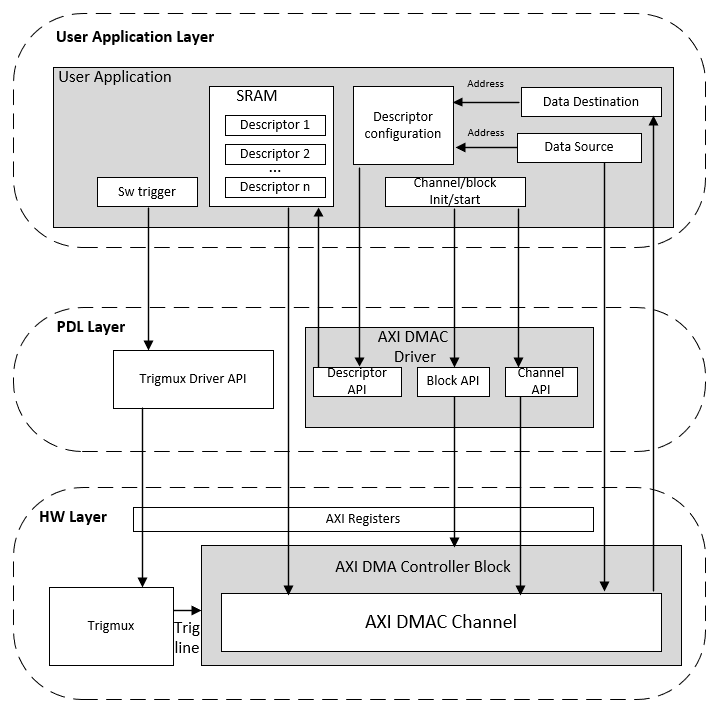Configures the AXIDMA Controller block, channels and descriptors.
The functions and other declarations used in this driver are in cy_axidmac.h. You can include cy_pdl.h to get access to all functions and declarations in the PDL.
The AXIDMA Controller channel can be used in any project to transfer data without CPU intervention basing on a hardware trigger signal from another component.
The AXIDMA Controller block has a set of registers, a base hardware address, and supports multiple channels. Many API functions for the AXIDMAC driver require a base hardware address and channel number. Ensure that you use the correct hardware address for the AXIDMA Controller block in use.
Features:
To set up a AXIDMAC driver, initialize a descriptor, initialize and enable a channel, and enable the AXIDMAC block.
To set up a descriptor, provide the configuration parameters for the descriptor in the cy_stc_axidmac_descriptor_config_t structure. Then call the Cy_AXIDMAC_Descriptor_Init function to initialize the descriptor in SRAM. You can modify the source and destination addresses dynamically by calling Cy_AXIDMAC_Descriptor_SetSrcAddress and Cy_AXIDMAC_Descriptor_SetDstAddress.
To set up a AXIDMAC channel, provide a filled cy_stc_axidmac_channel_config_t structure. Call the Cy_AXIDMAC_Channel_Init function, specifying the channel number. Use Cy_AXIDMAC_Channel_Enable to enable the configured AXIDMAC channel.
Call Cy_AXIDMAC_Channel_Enable for each AXIDMAC channel in use.
When configured, another peripheral typically triggers the AXIDMAC channel. The trigger is connected to the AXIDMAC channel using the trigger multiplexer. The trigger multiplexer driver has a software trigger you can use in firmware to trigger the AXIDMAC channel. See the Trigger Multiplexer documentation.
The following is a simplified structure of the AXIDMAC driver API interdependencies in a typical user application:

NOTE: Even if a AXIDMAC channel is enabled, it is not operational until the AXIDMAC block is enabled using function Cy_AXIDMAC_Enable.
NOTE: If the AXIDMAC descriptor is configured to generate an interrupt, the interrupt must be enabled using the Cy_AXIDMAC_Channel_SetInterruptMask function for each AXIDMAC channel.
Scenario: AXIDMAC with DMA descriptors, DMA config descriptors, source and destination buffer stored in memory other then DTCM(CM55 private MEMORY) such as SOCMEM or FLASH
Scenario: AXIDMAC with DMA descriptors, DMA config descriptors, source and destination buffer stored in DTCM memory (CM55 private MEMORY), in this case address need to be remap to external master mapped address
See the AXIDMAC chapter of the device technical reference manual (TRM).
| Version | Changes | Reason for Change |
|---|---|---|
| 1.0 | The initial version. |
API Reference | |
| Macros | |
| Interrupt Masks | |
| Functions | |
| Data Structures | |
| Enumerated Types | |